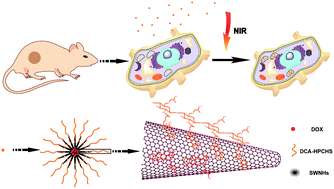In vitro and in vivo photothermally enhanced chemotherapy by single-walled carbon nanohorns as a drug delivery system†
Abstract
Single-walled carbon nanohorns (SWNHs) have exhibited many special advantages in biomedical applications. Herein, doxorubicin-loaded SWNHs (DOX-SWNHs) are prepared and further modified by amphiphilic deoxycholic acid modified-hydropropyl chitosan (DCA-HPCHS) to improve their biocompatibility. The obtained DOX-SWNH/DCA-HPCHS drug delivery system (DDS) possesses high stability in physiological media and excellent photothermal properties when exposed to laser irradiation in the near-infrared (NIR) region, which dramatically enhances the chemotherapy of DOX. Cell viability assays show that the growth of 4T1 cells are remarkably inhibitory under the conditions of incubation with DOX-SWNH/DCA-HPCHS and subsequent exposure to 808 nm laser irradiation to produce mild photothermal heating to 43 °C. Further investigation reveals that the photothermally enhanced chemotherapy derived from a promotion of DOX-SWNH/DCA-HPCHS uptake by the cancer cells rather than a light-triggered release of DOX. DOX-SWNH/DCA-HPCHS in combination with the use of laser irradiation exhibits a much better anticancer effect than the controls. Hence, the DOX-SWNH/DCA-HPCHS as a multifunctional DDS has been proposed and is hopeful for medicinal use in the future.


 Please wait while we load your content...
Please wait while we load your content...